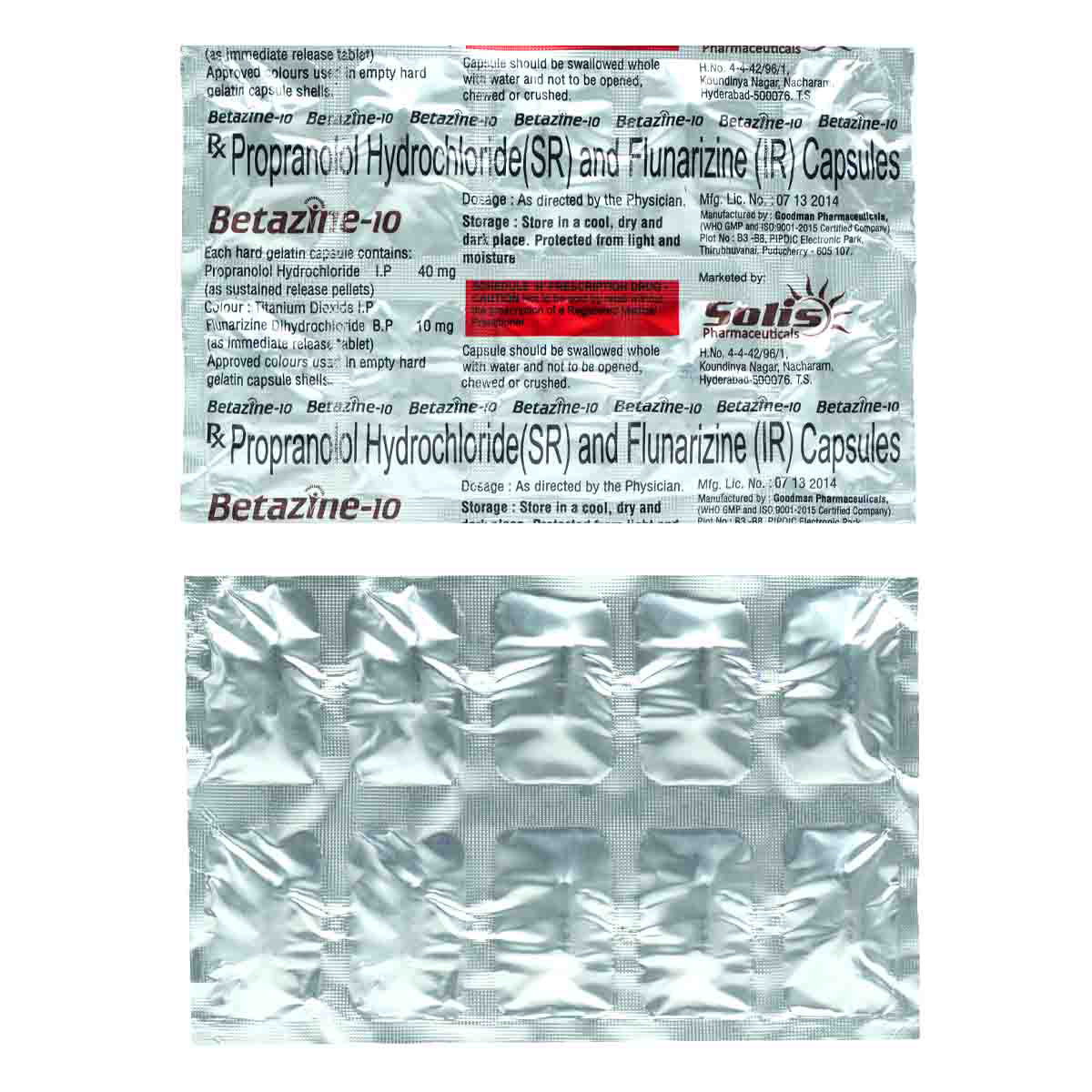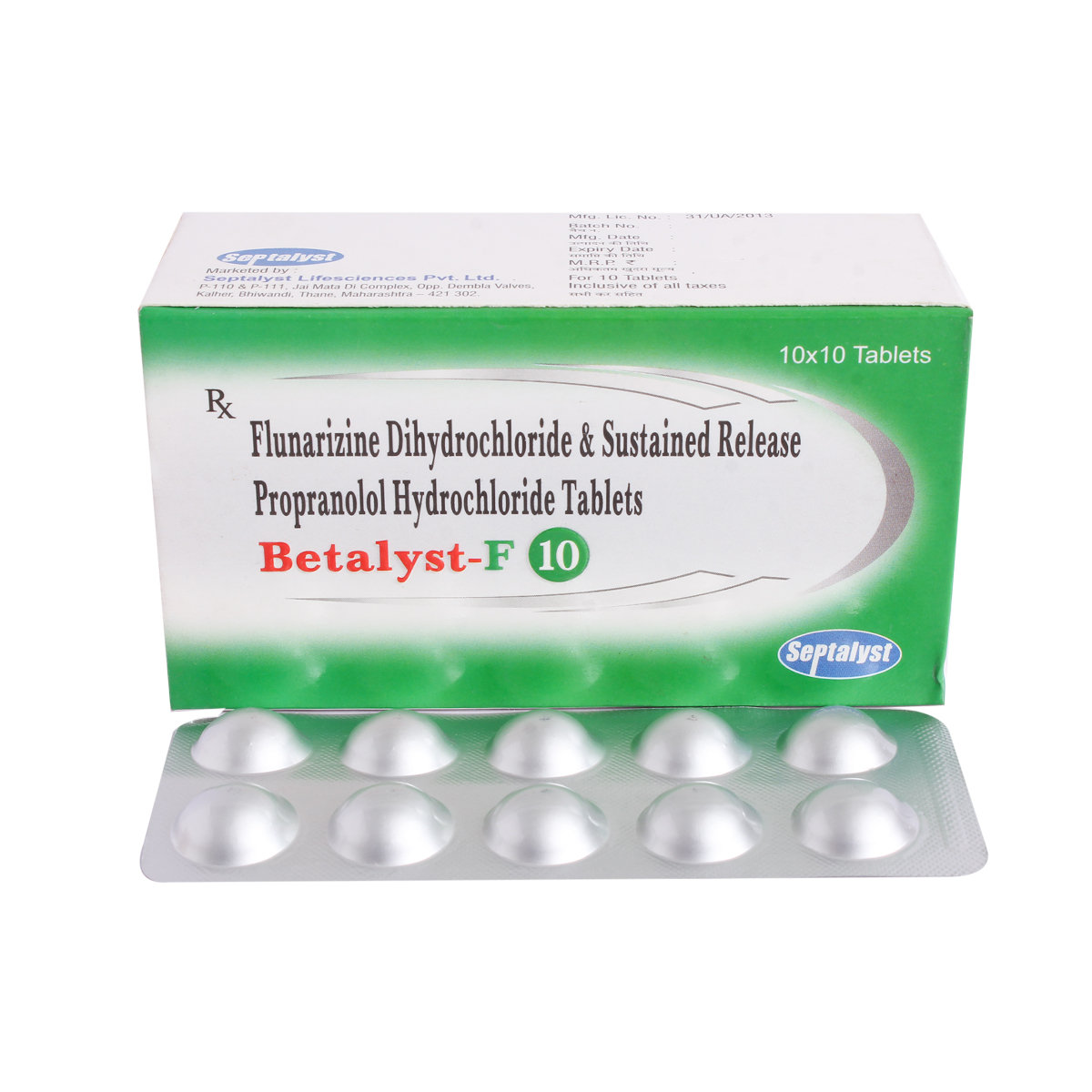Propranolol+flunarizine
About Propranolol+flunarizine
Flunarizine+propranolol is used to treat migraine. Migraine is a medical condition that involves severe throbbing pain or a pulsing sensation on one side of the head. Severe and recurrent headaches are one of the characteristic symptoms of migraine. Its symptoms include nausea, vomiting, difficulty speaking, numbness or tingling, and sensitivity to light and sound.
Flunarizine+propranolol consists of 'Propranolol' (beta-blocker) and 'Flunarizine' (calcium channel blocker). Propranolol has anxiolytic (anxiety-reducing), anti-arrhythmic (treats abnormal heart rhythms), and antihypertensive (reduces blood pressure) properties. Propranolol works by reducing cerebral (brain) blood flow by directly acting on the brain's blood vessels. It also inhibits the cortical spreading of depression and electrical activity in the brain that causes pain and inflammation. It effectively treats and reduces the severity and frequency of migraine headaches. Flunarizine belongs to the class of calcium channel blockers. It improves blood flow and dilates blood vessels in the brain, thereby preventing headaches caused by migraine. It is also used to treat vertigo (spinning sensation).
Your doctor will decide the dose and duration based on the severity of your pain. Common side effects of Flunarizine+propranolol include dry weight gain, slow heart rate, tiredness, depression, drowsiness, abnormal dreams, and cold extremities (hands and feet). These side effects are not familiar to everyone and vary individually. If you notice any side effects that are not manageable, please consult your doctor.
Let your doctor know if you use any prescription and non-prescription medications you are taking, including other vitamins, before starting Flunarizine+propranolol. Flunarizine+propranolol may cause weight gain in some cases, so avoid eating junk and eat a healthy, balanced diet, including home-cooked food. Consult your doctor before taking Flunarizine+propranolol if you are pregnant, planning for pregnancy or breastfeeding. Avoid consuming alcohol along with Flunarizine+propranolol as it could lead to increased drowsiness.
Uses of Propranolol+flunarizine
Medicinal Benefits
Flunarizine+propranolol is used to treat migraine. It consists of 'Propranolol' and 'Flunarizine'. Propranolol is a beta-blocker and has anxiolytic (anxiety-reducing), anti-arrhythmic, and antihypertensive properties. It works by lowering cerebral (brain) blood flow and inhibits cortical spreading depression, as well as electrical activity in the brain that causes pain and inflammation. It reduces the severity and frequency of migraine headaches. Flunarizine is a channel blocker that improves blood flow and dilates blood vessels in the brain, thereby preventing headaches caused by migraine.
Directions for Use
- Take Flunarizine+propranolol with or without food or as advised by a doctor.
- Follow your doctor's instructions on the dosage and timing of this medication, to ensure the safety.
- Swallow the medicine as a whole with glass of water.
- Do not crush, break, or chew it.
Storage
Side Effects of Propranolol+flunarizine
- Weight gain
- Slow heart rate
- Tiredness
- Depression
- Drowsiness
- Abnormal dreams
- Cold extremities (hands and feet)
Drug Warnings
Inform your doctor if you have any history of liver or kidney diseases, breathing problems (asthma, bronchitis, emphysema), diabetes, heart failure, heart rhythm problems (sinus bradycardia, Wolff-Parkinson-White syndrome, atrioventricular block), overactive thyroid, blood circulation problems (Raynaud's disease), adrenal gland tumour (pheochromocytoma), depression, metabolic acidosis (excess acid in the blood), and myasthenia gravis (muscle weakness) before starting Flunarizine+propranolol. Please consult your doctor if you are pregnant and planning to conceive if the doctor advised you Flunarizine+propranolol. Avoid consuming alcohol along with Flunarizine+propranolol as it could lead to increased dizziness and drowsiness.
Drug Interactions
Drug-Drug Interaction: Flunarizine+propranolol may interact with mood disorder medicines (alprazolam, quetiapine, aripiprazole), drugs treating sleeping problems (zolpidem), respiratory drugs (diphenhydramine), antidepressants (sertraline, duloxetine, fluoxetine), and fits medicine (carbamazepine, phenytoin).
Drug-Food Interaction: Alcohol may cause dizziness and drowsiness when taken with Flunarizine+propranolol.
Drug-Disease Interaction: Before using Flunarizine+propranolol, let your doctor know if you have any liver, kidney or heart diseases, asthma, depression, muscle disorders, metabolic acidosis, diabetes, and alcohol dependency.
Drug-Drug Interactions Checker List:
Safety Advice

Alcohol
unsafeYou are recommended to avoid alcohol consumption while taking Flunarizine+propranolol. Alcohol intake, along with Flunarizine+propranolol, may cause increased dizziness and drowsiness.

Pregnancy
cautionPlease consult your doctor if you are pregnant or planning to conceive before using Flunarizine+propranolol.

Breast Feeding
cautionPlease consult your doctor before taking Flunarizine+propranolol if you are a lactating mother.

Driving
cautionFlunarizine+propranolol may make you feel drowsy. Do not drive or operate machinery if you experience drowsiness.

Liver
cautionTherapy with propranolol should be administered cautiously in patients with liver disease. Please consult your doctor if you have a history of liver impairment/liver disease.

Kidney
cautionPlasma clearance of Propranolol in Flunarizine+propranolol is reduced in patients with renal failure. Please consult your doctor if you have a history of kidney impairment/kidney disease.

Children
safe if prescribedFlunarizine+propranolol is safe to use for children below 12 years of age when prescribed by the doctor.
Habit Forming
Diet & Lifestyle Advise
- Avoid chocolates, junk food, cheese, processed food, alcohol, and smoking. Instead, eat a healthy diet and do regular exercise to avoid weight gain caused due to Flunarizine+propranolol.
- Avoid loud music, extreme temperatures, bright lights, and noisy places as it can increase headache.
- You can try increasing your mindfulness by doing yoga, meditation, mindfulness-based cognitive therapy, and stress reduction techniques.
- Drink enough water to stay hydrated and limit or avoid alcohol and caffeine to relieve headaches.
- Include a diet rich in whole grains, vegetables, and fruits. This is a healthier option than eating a lot of simple carbohydrates found in processed foods.
- You can include antioxidants in your daily diet like ashwagandha, omega-3 fatty acids, green tea, and lemon balm.
- Try to spend time with your friends and family. Having a strong social network may help you lower your risk of anxiety.
Special Advise
Let your doctor know that you are taking Flunarizine+propranolol if you are undergoing any medical tests.
Beta-blockers like Propranolol can mask hypoglycaemia symptoms (low blood sugar) or hyperthyroidism (high thyroid levels).
It is advised to inform your doctor if you have diabetes or thyroid disease before using Flunarizine+propranolol.
Beta-blockers can also cause changes in serum lipid profiles. Patients with pre-existing hyperlipidaemia (high lipid levels) should be closely monitored if using Flunarizine+propranolol.
Patients Concern
Disease/Condition Glossary
Migraine: It is a medical condition that involves severe throbbing pain or a pulsing sensation on one side of the head. Severe and recurrent headaches are one of the characteristic symptoms of migraine. Symptoms of migraine may include nausea, vomiting, difficulty speaking, numbness or tingling, and sensitivity to light and sound. Migraine can be triggered by various factors like foods (eggs, tomatoes, onions, dairy products, wheat, pasta, citrus fruits, nitrites found in foods, alcohol, and red wine), hormonal changes, sleep changes, stress, loud noises, and medications.
FAQs
Flunarizine+propranolol belongs to the class of anti-migraine drugs used to treat migraine.
Flunarizine+propranolol is a combination of two drugs: Propranolol and Flunarizine. Flunarizine+propranolol treats migraine by reducing the blood flow to the brain, and inhibits cortical spreading depression, electrical activity in the brain that causes pain and inflammation.
Flunarizine+propranolol may sometimes cause weight gain during its prolonged use. It is always advised to maintain a well-balanced, healthy diet and exercise regularly.
Flunarizine+propranolol does not work for a sudden migraine attack. It is helpful in only preventing new episodes of migraine headaches. Please let your doctor know if you have sudden attacks to be prescribed other suitable medications.
Flunarizine+propranolol is contraindicated in asthma, slow heart rate, abnormal heart rhythms, heart conditions like AV (Atrioventricular) block or sick sinus syndrome, depression, and Parkinson's disease. Please consult your doctor before starting Flunarizine+propranolol if you have a medical history.
Your doctor will prescribe Flunarizine+propranolol to prevent any new episodes of migraine. Please do not stop taking this medicine unless advised by your doctor since it may lead to recurrent episodes of migraine. Flunarizine+propranolol also contains Propranolol, and its sudden withdrawal may cause sweating, shaking, irregular heartbeat, and worsening of underlying angina or heart attack. Hence, do not stop using Flunarizine+propranolol unless advised by your doctor.
Flunarizine+propranolol may cause sleepiness in some individuals as a potential side effect. If this occurs, exercise caution and avoid activities that require mental alertness, such as driving or operating heavy machinery.
Store Flunarizine+propranolol at room temperature in a cool and dry place, away from sunlight and moisture. Keep out of reach of children.
The common side effects of Flunarizine+propranolol are weight gain, slow heart rate, tiredness, depression, drowsiness, abnormal dreams, and cold extremities (hands and feet). Please consult your doctor if any of these side effects persist or worsen.






